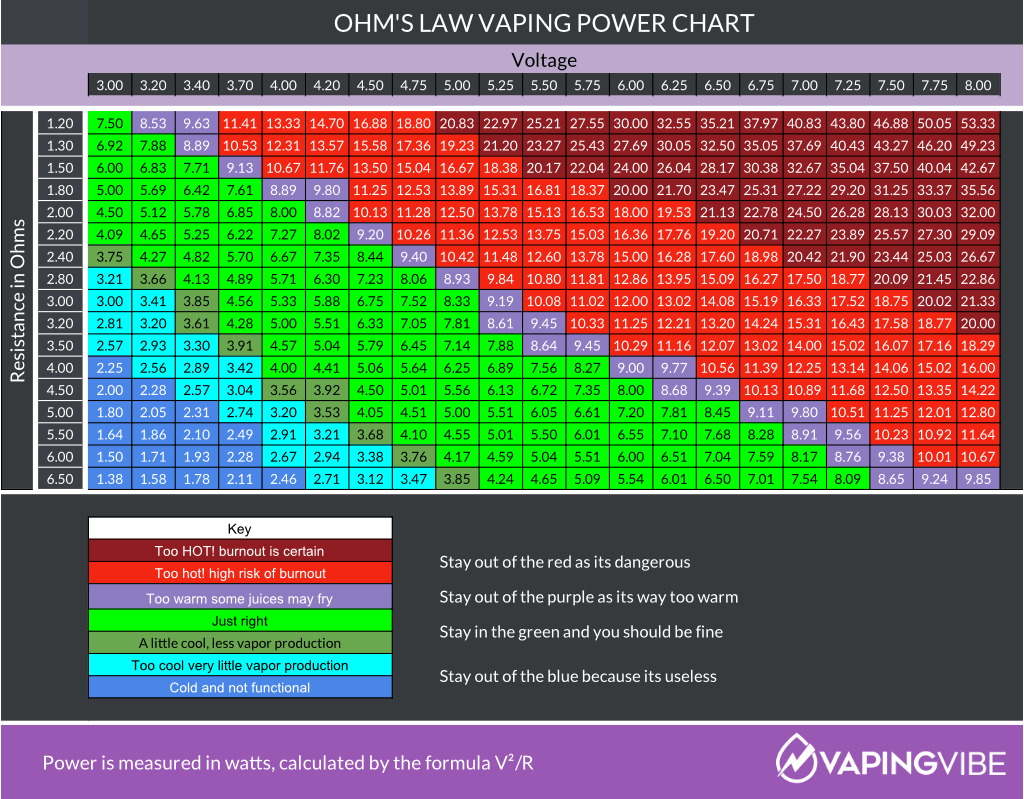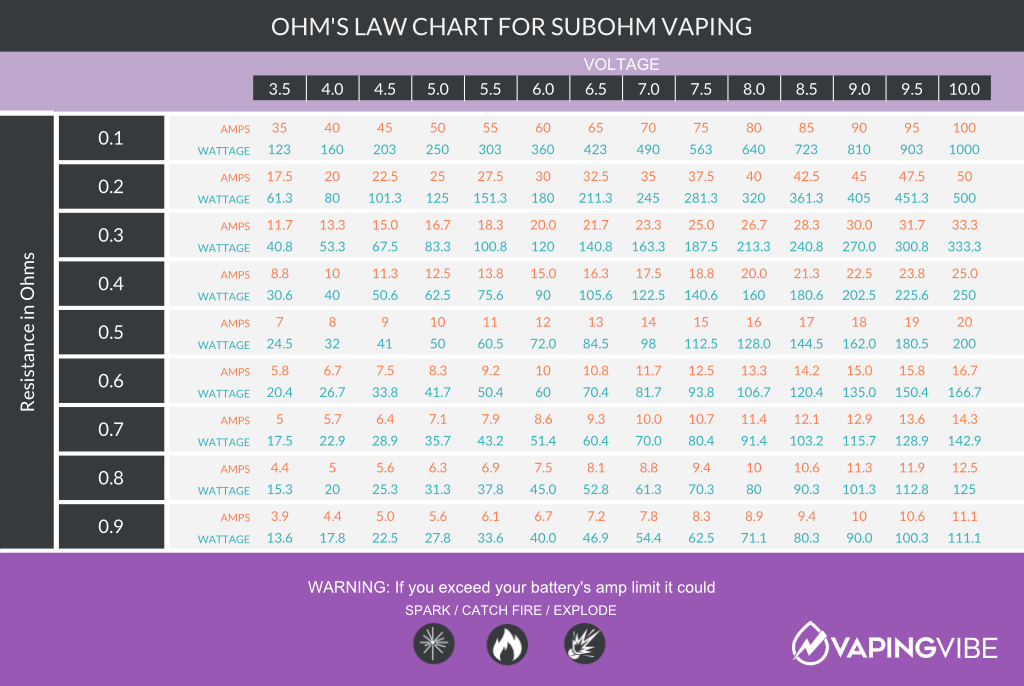What is Ohm's law?
Ohm’s law is the primary relationship between voltage, current, and resistance in DC electrical circuit. Discovered and named after the German physicist Georg Ohm and published in 1827.
Ohm’s law states that the current through a conductor between two points is directly proportional to the voltage across the two points. Ohm explained his experimental results by a slightly more complicated equation than the modern one which is shown as a simple triangle. It’s also simple enough that you can learn to calculate the formula with a calculator, which you can find on any mobile phone – or you can use our calculator above.
Why do I need Ohm’s Law?
Vaping safety starts with understanding the limitations of your battery. Now that mechanical mods, high wattage regulated mods, rebuildable dripping atomizers, and rebuildable tank atomizers are becoming increasingly popular, it’s in your interest to be safe. After all, you are putting a high voltage or high wattage battery into a metal tube putting it up to your mouth and hitting the fire button!
Experienced vapers soon learn that they can save a lot of costs if they start rebuilding RDA’s / RBA’s and RTA’s as part of their daily life. The building block of most vape coils is Kanthal wire and organic cotton, and you can fund a year’s supply for the same as a pack of coils.
Understanding how to measure the resistance (ohms) of the coil on your atomizer is the first step to safety. The pro’s like to use a digital meter, but most modern day mods will tell you the resistance of the coil you’ve built – always make sure you don’t have it powered on until you are ready to measure the resistance.
The batteries used for most mechanical and box mods are either 18650 or 26650. A batteries ability to discharge stored energy is measured in Amps. If you push the battery to its limits the chemicals inside will get hot and start to vent, hot chemicals exiting under high pressure is how a battery blows up!
It sounds scary, but that’s why you should never push a battery beyond its ability. Always check the resistance of your coil and calculate the amps the coil will draw from the battery, using either the volts for mechanical mods, which is 4.2v for most 18650 and 26650 batteries) or the watts you will set on your box mod.
What is Sub-Ohm Vaping?
Sub-Ohm vaping when you build a coil that has a resistance of less than one ohm. The reason you might want to do this to increase the power output of a device that has a fixed voltage such as a mechanical mod or non-variable regulated device. This is really for advanced vapers who “Sub-Ohm” to create more flavor or vapor.
Ohm's Law Triangle
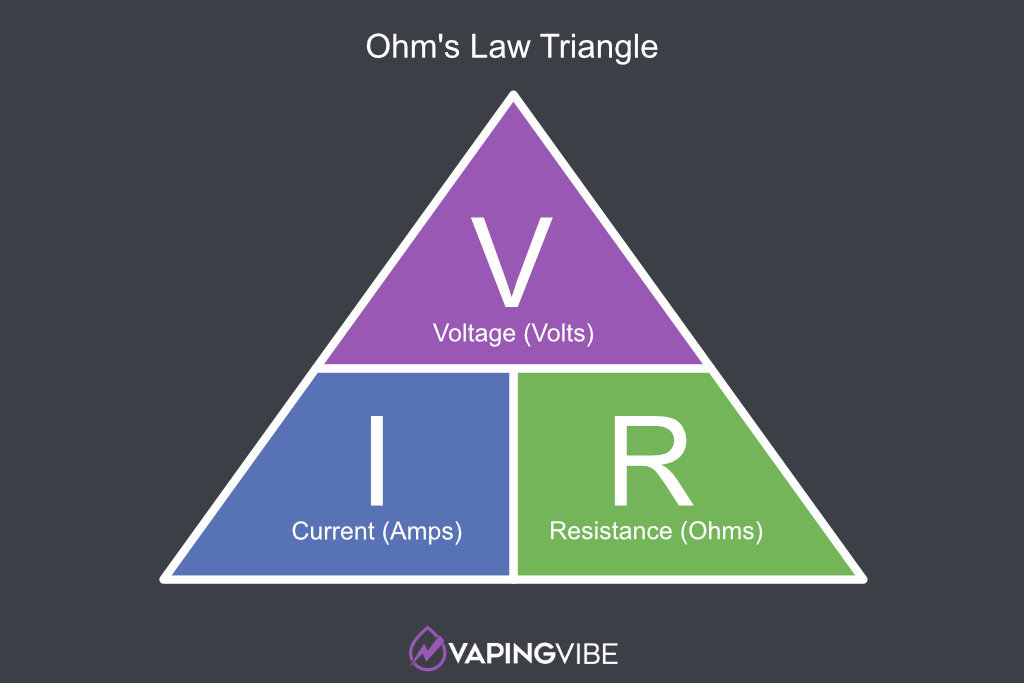
The triangle is represented by the relationship of the three main components that exist in an electrical circuit. Which are the V (Voltage), I (Current) and R (Resistance). To remember it the phrase that gets taught in any electrical class goes “V over I times R” or shown as the formula:
[ V = I x R ] V (volts) = I (amps) x R (Ω)
All that you have to remember is what the letters stand for in the formula; the easiest is “V” and “R” but “I” is a little harder as it stands for intensité (intensity). Described by the French scientist André-Marie Ampère as “l’intensité du courant électrique.”
- V is the Voltage of your battery in Volts
- I is the current drawn by your coil in Amps
- R is the resistance of your your coil in Ohms
Now that you know the relationship between voltage, current, and resistance you can use the triangle to help build your coils to get the current and wattage you want.
Calculating Current
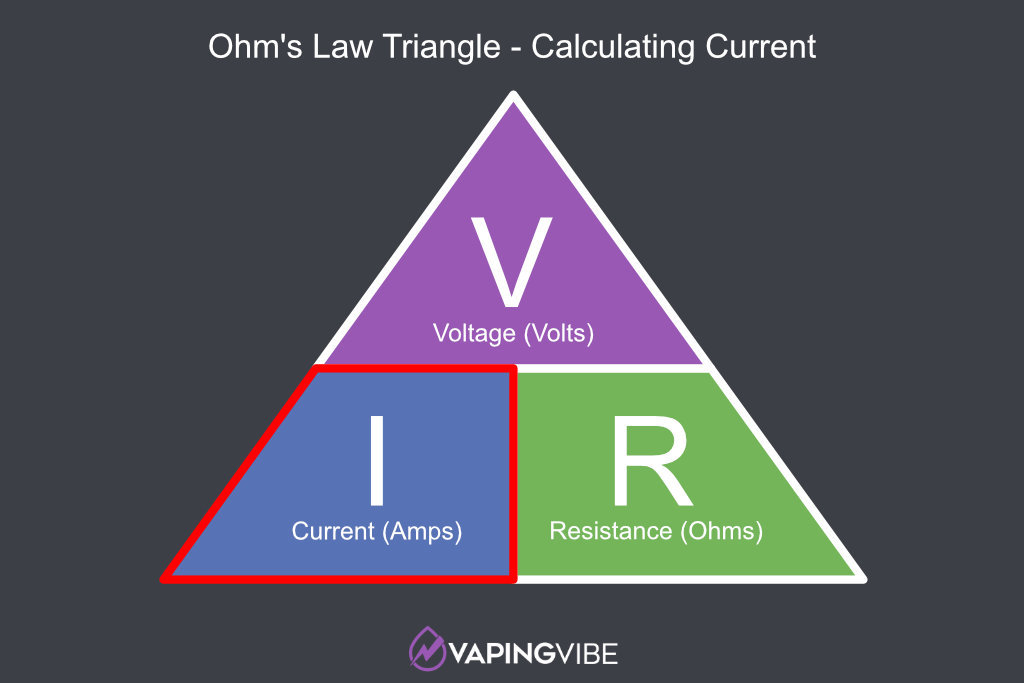
Using Ohm’s Law triangle as a reference, we can now calculate the missing value in the formula, in this case, the current drawn through the resistance of your coil by dividing the voltage (V) by the resistance (R).
[ I = V ÷ R ] I (amps) = V (volts) ÷ R (Ω)
Using a real-life example with a mechanical mod and a freshly charged battery we have 4.2V of power available at the coil. If you have a coil with a resistance of 0.5Ω you now have everything you need to calculate the current in amps.
I = 4.2V ÷ 0.5Ω (or 4.2/0.5)
therefore I = 8.4A
So having a 0.5Ω coil and a freshly charged battery at 4.2V, the result is 8.4 Amps of current draw. As your battery starts to drain the current will begin to decrease, which means when the battery reaches 3.6V with the same load, the current will have dropped to 7.2A (I=3.6/0.5)
Calculating Power (Wattage)
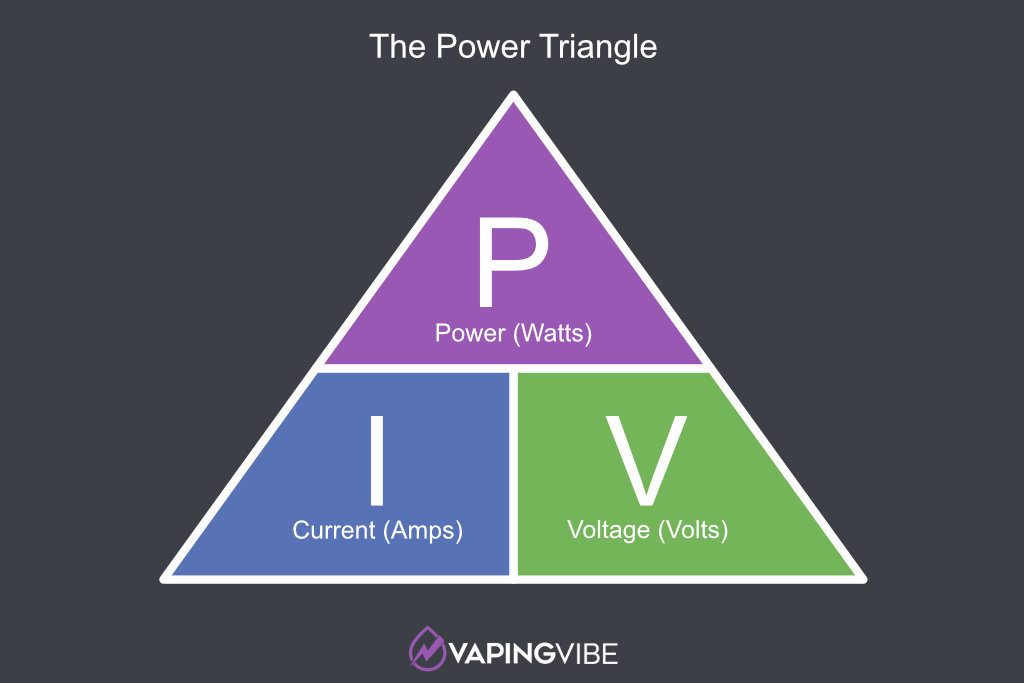
Using the same triangle principle, the other element you will want to know is the electrical power (P) or wattage that is going to be generated at the coil. We still need the voltage and amps to find our missing value:
[ P = V x I ] P (Watts) = V (Volts) x I (Amps)
Superimposing the three quantities into the triangle, we can create what is called a Power Triangle with the power at the top and current and voltage at the bottom.
Using the same example as before of a 0.5Ω coil with a fully charged battery at 4.2V it will pull 8.4 amps, using this in our new formula will give us the power or wattage.
P = 4.2V x 8.4A
therefore P = 35.28W
From using both our formulas, you can see that if the resistance of the coil increases, then it will let less current flow (calculating current formula), therefore, generating less power (calculating power formula).
Calculating Resistance
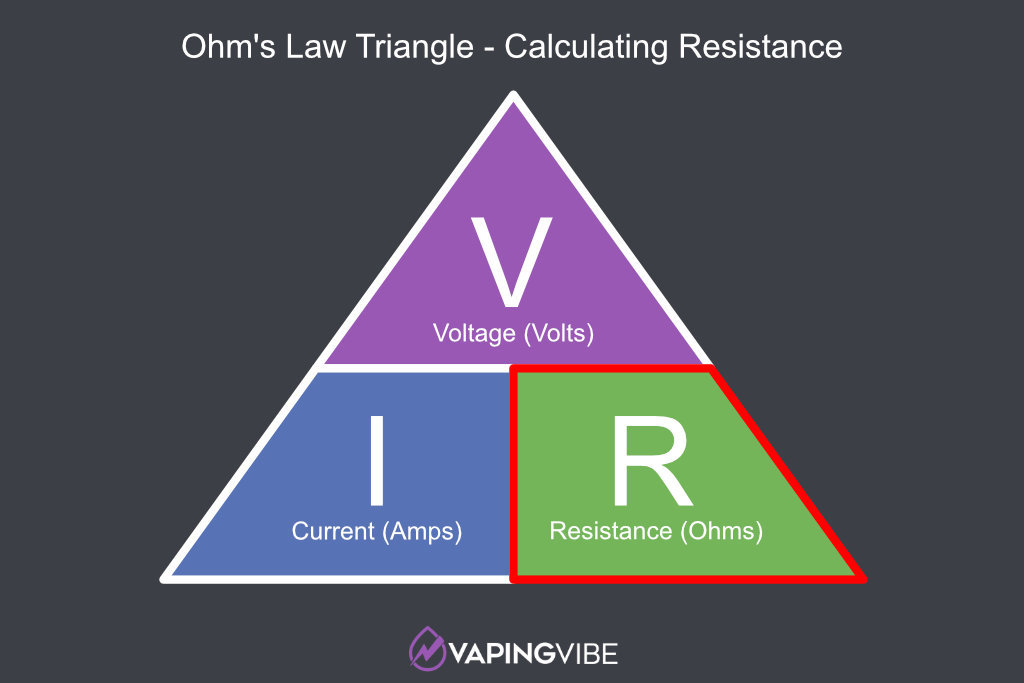
The second formula in Ohm’s law uses the voltage and the current to calculate the resistance. If you have a battery which has a 20A current limit, you might want to calculate the resistance of the coil you can safely use without exceeding the continuous discharge rate (CDR) of the battery.
To calculate this, we can refer back to the triangle and use the formula:
[ R = V ÷ I ] R (Ω) = V (volts) ÷ I (amps)
For safety, it is best to underestimate the CDR of your battery. We know the battery is 20A, but we’ll use 19A to give us a 1A margin. We also know our battery has a max voltage of 4.2V on a single battery mod. So the calculation is as follows:
R = 4.2V ÷ 19A
therefore R = 0.22Ω
This result gives us a safe lower limit for a 20A battery of 0.22Ω, and this provides us with the lowest current limit of the battery without it exploding.
Calculating Voltage
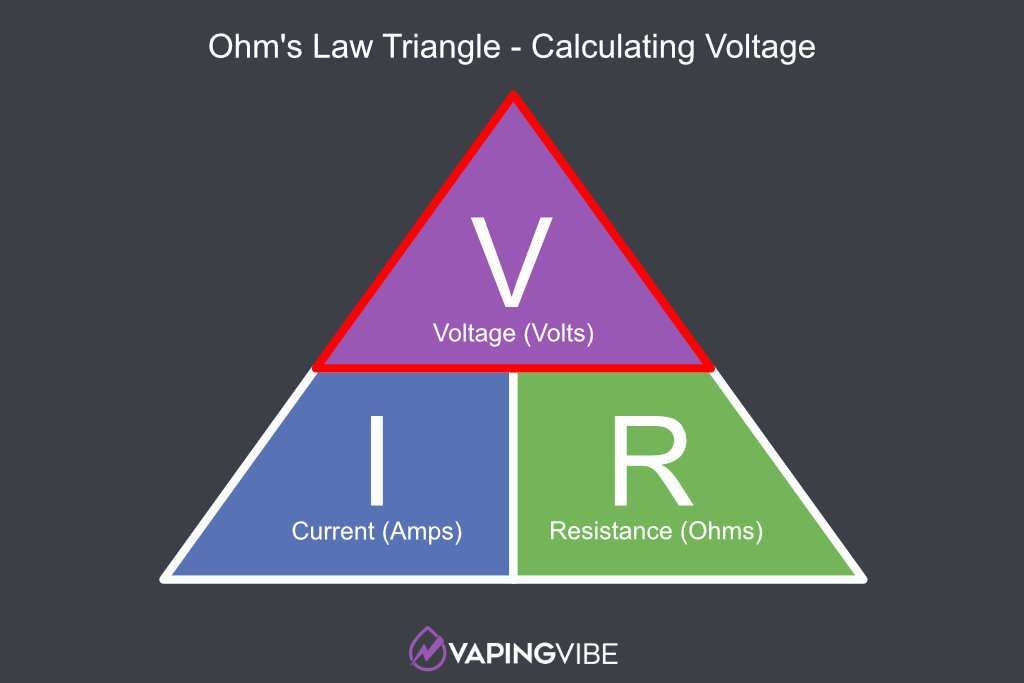
The last remaining formula is not applicable to vaping as we already know the voltage from our battery and would need to know the current and the resistance (the two that we need to calculate)
Just complete the full triangle should you need to determine the voltage when current and resistance is known, the formula looks like this:
[ V = I x R ] V (volts) = I (amps) x R (Ω)
Conclusion
The most useful of these formulas are the ones that calculate current, power and resistance. These will allow you to calculate the current that your coil will draw and therefore the wattage that will appear.
The most important thing to remember is if you increase the resistance then the current and power will drop off. If you decrease resistance, then the current and power will increase.
Knowing the power will increase as you lower the resistance (Sub-Ohm vaping) and using the resistance formula to calculate a low resistance from the continuous discharge rate (CDR) of your battery will help keep you safe and adjust the power at the coil.
As mentioned at the beginning of this article we are using the simple version of the formula, and this doesn’t take into account other factors such the time it takes for the coil to heat up or the energy lost from the heat of the coil. If we offset this by assuming the battery is always fully charged at 4.2 volts (or 8.4 volts in dual mode) then we will always remain safe with our calculations.

